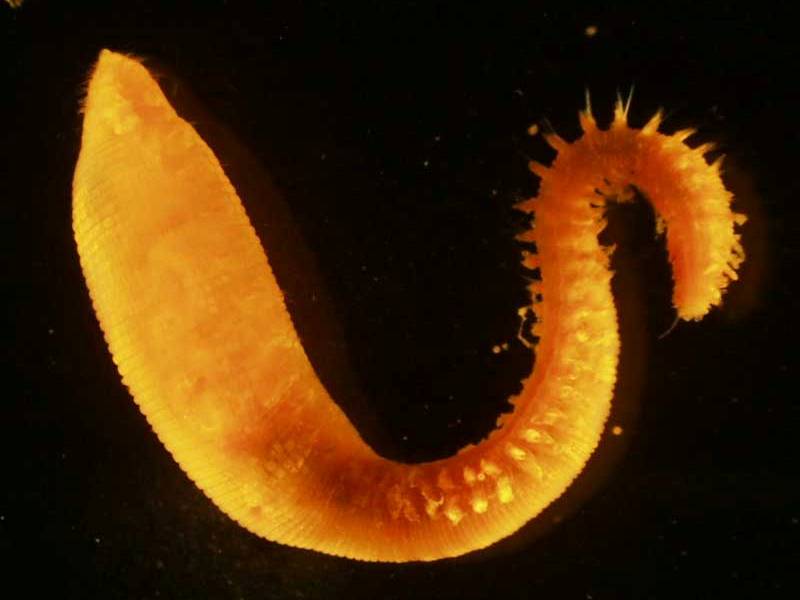A bristleworm (Scalibregma inflatum)
Distribution data supplied by the Ocean Biodiversity Information System (OBIS). To interrogate UK data visit the NBN Atlas.Map Help
| Researched by | Emma Snowden | Refereed by | Admin |
| Authority | Rathke, 1843 | ||
| Other common names | - | Synonyms | - |
Summary
Description
Recorded distribution in Britain and Ireland
Widespread around the UK, few records for Ireland.Global distribution
From the Arctic all around Britain to the Atlantic coast of Europe.Habitat
Found around low water mark and in the shallow sublittoral, buried deep in sand or mud.Depth range
-Identifying features
- Body 5-10 cm long.
- Swollen at the front, becoming slender towards the rear.
- The head has two anterior lateral projections forming a T shape.
- Four pairs of branching gills present on the second to fifth segments.
- From about segment 16, finger-like dorsal and ventral cirri present.
- The posterior end bears four or five thread-like cirri.
- Purplish red with yellow blotches.
Additional information
Scalibregmatidae (sometimes called maggot worms) are not routinely encountered, although they can occur in huge numbers in shallow waters in northern Europe. More often, they occur in muddy sediments at more than 1000 m depth. They are active burrowers and feed on detritus in sediment and never form tubes.Listed by
- none -
Bibliography
Hayward, P., Nelson-Smith, T. & Shields, C. 1996. Collins pocket guide. Sea shore of Britain and northern Europe. London: HarperCollins.
Hayward, P.J. & Ryland, J.S. (ed.) 1995b. Handbook of the marine fauna of North-West Europe. Oxford: Oxford University Press.
Howson, C.M. & Picton, B.E., 1997. The species directory of the marine fauna and flora of the British Isles and surrounding seas. Belfast: Ulster Museum. [Ulster Museum publication, no. 276.]
Pleijel, F. & Dales, R.P., 1991. Polychaetes: British Phyllodocoideans, Typhloscolecoideans and Tomopteroideans. Oegstgeest, The Netherlands: U.B.S./Dr. W. Backhuys. [Synopsis of the British Fauna No. 45.]
Rouse, G.W. & Pleijel, F., 2001. Polychaetes. New York: Oxford University Press.
Stachowitsch, M., 1992. The invertebrates: an illustrated glossary. USA: Wiley-Liss.
Datasets
Centre for Environmental Data and Recording, 2018. Ulster Museum Marine Surveys of Northern Ireland Coastal Waters. Occurrence dataset https://www.nmni.com/CEDaR/CEDaR-Centre-for-Environmental-Data-and-Recording.aspx accessed via NBNAtlas.org on 2018-09-25.
Environmental Records Information Centre North East, 2018. ERIC NE Combined dataset to 2017. Occurrence dataset: http://www.ericnortheast.org.ukl accessed via NBNAtlas.org on 2018-09-38
Merseyside BioBank., 2018. Merseyside BioBank (unverified). Occurrence dataset: https://doi.org/10.15468/iou2ld accessed via GBIF.org on 2018-10-01.
NBN (National Biodiversity Network) Atlas. Available from: https://www.nbnatlas.org.
OBIS (Ocean Biodiversity Information System), 2025. Global map of species distribution using gridded data. Available from: Ocean Biogeographic Information System. www.iobis.org. Accessed: 2025-05-19
South East Wales Biodiversity Records Centre, 2018. SEWBReC Worms (South East Wales). Occurrence dataset: https://doi.org/10.15468/5vh0w8 accessed via GBIF.org on 2018-10-02.
Citation
This review can be cited as:
Last Updated: 17/04/2008



